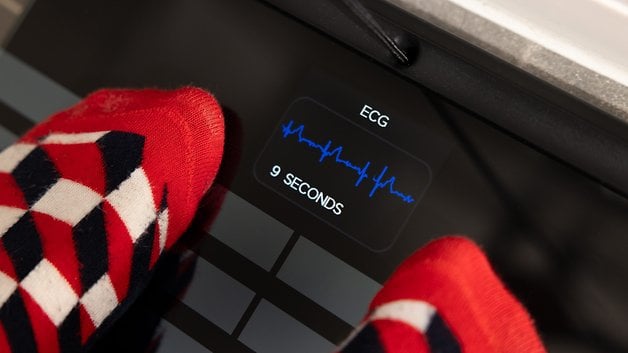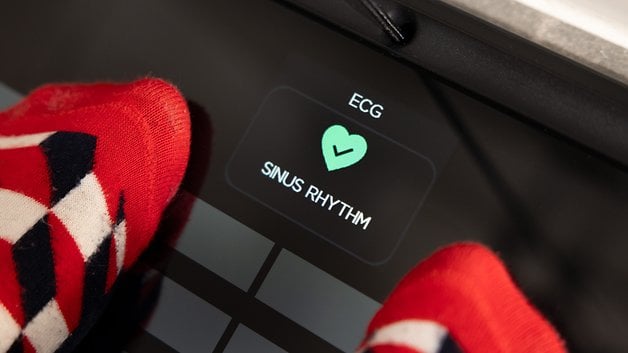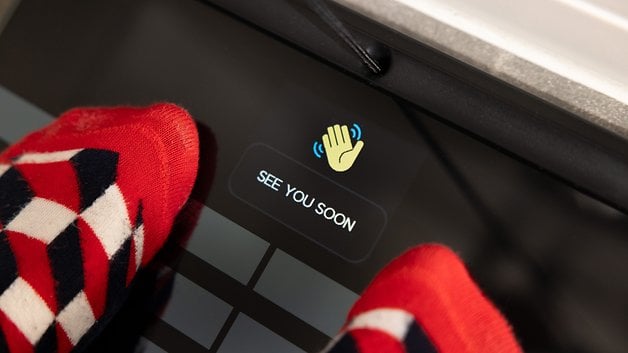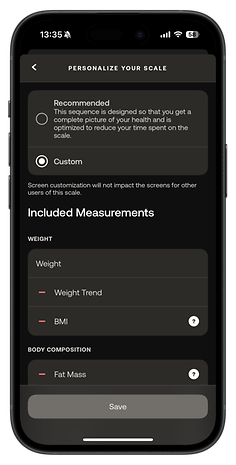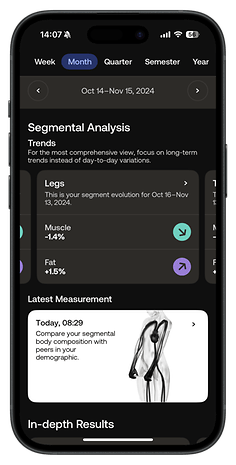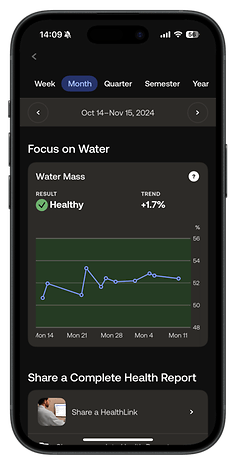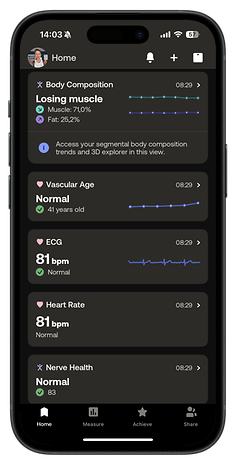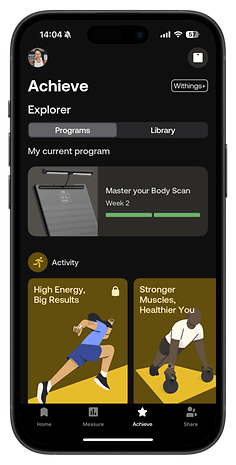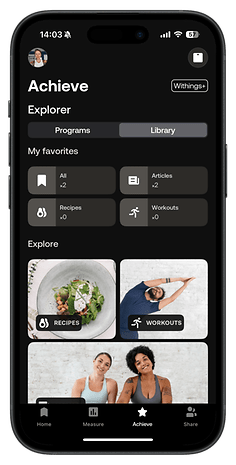How This Withings Smart Scale Transformed My Understanding of My Body


If you're on the lookout for a smart scale that offers a truly comprehensive overview of your body composition, the Withings Body Scan might just be the perfect addition to your digital health toolkit. After using it for some time, I've found it to be incredibly insightful—not just for tracking weight, but also for deeper metrics like segmental body composition. Withings is a pioneer in smart health devices, and it has clearly raised the bar with this $400 model. But does it live up to its promise of being the ultimate at-home health companion? Let's dive in to find out.
Good
- Comprehensive health tracking
- Premium build quality and sleek design
- Intuitive app with multi-user support
- Segmental analysis provides unique insights
Bad
- High price may deter casual users
- Withings+ subscription lacks clear value
- Nerve health monitoring feels too niche for most users

Design and Build Insights for the Withings Body Scan
The Withings Body Scan comes in sleek, premium packaging, making the unboxing process a straightforward affair. Inside the box, you'll find the scale, a wall-mount handle, an instruction manual, and a USB-C charging cable. Setup is quick and intuitive—just pair it with the Withings Health Mate app (Android | iOS), and you're all set.
Yes, the scale functions independently, but for full access to features and historical data, the app is indispensable.
The Body Scan is slim for a device packed with so much technology. The tempered glass platform feels solid underfoot, while the extra-wide design provides stability. One standout feature is the extendable handle with integrated electrodes—used for more advanced readings like segmental body composition and ECG.
The scale is available in black and white, making it suitable for any bathroom decor.
An interesting discovery for me was that, unlike my Xiaomi Body Composition Scale 2*, this smart scale doesn’t rely on replaceable batteries. Instead, Withings opted for a USB-C charging port. It takes up to 5 hours to fully charge its 3.7V, 2500mAh lithium-ion battery. However, once fully charged, it offers impressive longevity, lasting up to a year under typical usage conditions, according to the manufacturer.
Customizable Screens
At the top of the smart scale, there's a high-resolution color LCD screen that delivers clear readings—at least to a person with typical vision like me. While navigating through the screens is somewhat limited, it remains highly intuitive. The smart scale supports up to eight users and can automatically recognize each one based on their unique metrics. Alternatively, you can manually switch profiles by pressing either their right or left foot to navigate through them.
One standout feature is the customizable screens available in the app, allowing you to configure up to 16 sequences of data. For instance, you can display weight trends and Body Mass Index (BMI) on your weight screen, or enhance the body composition metrics with up to five components, including fat, bone, and muscle mass, visceral fat, and body water.
However, adding more metrics will extend the time required for a full measurement. In total, the recommended sequence takes about 90 seconds, with the ECG alone taking 30 seconds.
I appreciate this level of customization on the smart scale, as it offers a wealth of information at a glance without needing to open the app. At the same time, it provides practicality—allowing you to view only the most relevant metrics on the scale while using the app for a more comprehensive analysis.
Additionally, each user profile supports four customizable modes, adjustable via the app: Athlete, Eyes-closed, Weight-only, and Pregnancy.
| Withings Body Scan Modes | |
|---|---|
| Athlete Mode |
|
| Eyes-closed Mode |
|
| Weight-only Mode |
|
| Pregnancy Mode |
|
Key Features of the Withings Body Scan
The Withings Body Scan has earned multiple certifications to guarantee its safety and effectiveness. It holds FDA clearance for the ECG features in the United States and has received CE Marking in compliance with European health and safety standards.
So, what does this mean for us? It means that Withings can offer some of their advanced features as medically approved while others are available only as wellness functions—something I’ll address throughout this review. For now, let me highlight a few standout features that I find particularly noteworthy.
Comprehensive Body Composition Analysis
The Body Scan goes beyond simple weight measurements, providing a detailed breakdown of your body fat percentage, muscle mass, bone mass, and visceral fat levels. The standout feature is its segmental analysis, which individually measures the composition of your arms, legs, and torso using its retractable handle. This is particularly beneficial for fitness enthusiasts aiming to track muscle growth or fat loss in specific areas.

All of this is made possible by Bioelectrical Impedance Analysis (BIA), a sophisticated technology that sends a low-level electrical current through your body using eight electrodes (four embedded in the glass base and four in the handle). The current travels faster through water and muscle but slows down in fat tissue, enabling the scale to deliver precise body metrics.
With this tech, you can obtain all these readings in seconds.
You might already be familiar with BIA, as it's featured in some smartwatches, like those from Samsung. However, the Withings Body Scan offers a higher level of reliability, thanks to the more complex sensors involved in the process compared to the Samsung Galaxy Watch Ultra (review).
Since I believe body composition is powerful data for anyone trying to improve muscle mass, I've also been using the Body Scan alongside my Whoop 4.0 to track gains and losses by analyzing the BIA metrics. In fact, this combination is what motivated me to write this review.
However, there are some important considerations according to Withings:
- The electrical current used for body composition measurements is low voltage and safe for most users. However, pregnant individuals should avoid this feature or disable it via the app—using the Pregnancy mode can help bypass this issue.
- Those with pacemakers, ICDs, or other implanted devices must not use this function, as it could cause interference.
Nerve Activity Score
This may be the most high-tech feature of the Body Scan scale. The Nerve Activity Score measures how well your nerves are functioning by analyzing sweat gland activity in your feet. As with the Body Composition Analysis, it works by sending a very low electrical current through special electrodes on the scale.
This current draws chloride ions from your sweat glands to the surface. If your nerves are healthy and well-connected, more chloride ions will be pulled out, showing strong sweat activity. But if your nerves are less active, fewer ions are released, which can indicate possible nerve damage.
This feature is particularly relevant for those at risk of conditions like diabetic neuropathy, where nerve function gradually declines. With approximately 537 million adults worldwide currently living with diabetes (International Diabetes Federation for 2021), having a device that can monitor and flag early signs of nerve deterioration is incredibly valuable.
However, as I don’t fall into the at-risk group, it's challenging for me to fully assess the impact of this measurement. I’d recommend consulting with your physician to determine whether this feature could provide valuable insights into your specific condition. For me personally, I see its relevance increasing as I continue to age and prioritize proactive health monitoring.
Important note: Interestingly, in the US, the Nerve Activity Score is referred to as “Electrodermal Activity Score (EDA)” and is positioned as a wellness metric. Since I tested the scale in Germany, where I happen to live, I’m referring to this feature as the Nerve Activity Score.
Vascular Age Estimation
When it comes to Vascular Age Estimation, I have to admit, I’m a bit skeptical. The reason is simple: it’s an indicator that can vary significantly depending on the device and measurement technique used. In my experience, my vascular age fluctuates quite a bit depending on the tool.
For instance, my Egym app refers to it as BioAge, breaking it down into categories like strength, flexibility, metabolism, and cardio. Meanwhile, the Zepp app calls it Body Age, and the Withings Body Scan measures it as Vascular Age. Interestingly, while the Egym app and Body Scan usually estimate my cardio/vascular age quite accurately, placing me around 40-41, the Zepp app is much more generous, rating me at 34. Egym also gives me a range of 27-35 across its various categories.
I share this because these readings can vary widely depending on the device and technique. The Body Scan, in particular, uses Pulse Wave Velocity (PWV) measurements to estimate vascular age—a key indicator of arterial stiffness and overall cardiovascular health.
Of all the devices I’ve tried, the Withings Body Scan comes closest to aligning with how I actually feel—essentially, my actual age. And yes, it does motivate me to hit the gym more often, whether it’s to keep up with my age or maybe even feel a bit younger.
Important note: In the U.S., Vascular Age is offered as a wellness metric on the Body Scan, as it hasn’t yet received FDA clearance. The underlying Pulse Wave Velocity technology is still undergoing regulatory review and standardization.
6-Lead ECG Monitoring
Last but not least, the Body Scan has the capability to perform a 6-lead ECG, using the handle to deliver a more comprehensive heart health reading compared to the standard single-lead measurements found in most wearables, like the Apple Watch.
The ECG can detect signs of atrial fibrillation (AFib), making it a valuable tool for those concerned about heart health. Personally, I fall into the typical heart health range, so I would advise consulting with your doctor to determine which type of heart monitoring is best for you—whether it’s a device worn on your wrist 24/7, like the Withings Scan Watch 2 (review), or one you use daily in your bathroom, like the Body Scan.
In any case, the Body Scan offers a more thorough assessment due to its 6-lead ECG technology. Furthermore, the app offers the convenience of sharing your electrocardiogram directly with your healthcare provider.
User Experience and App Integration
Setting up the scale with the Withings Health Mate app is seamless. The app is well-designed, with a clean, intuitive interface that makes it easy to navigate through your health data. You can track weight, body composition, ECG, and nerve activity over time, with historical data presented in an easy-to-read format.
As mentioned before, the app also supports multiple profiles, and the integration with platforms like Apple Health, Google Fit, Samsung Health, Strava, and MyFitnessPal means your data can be synchronized across all your devices.
Withings+ Subscription
Yes, there’s a Withings+ subscription that offers insights based on your health metrics, personalized plans, and long-term trend analysis. However, the subscription is entirely optional, and you’ll receive a 3-month free trial when purchasing the smart scale. In my opinion, the free version already provides a solid, comprehensive overview of your data, making the subscription largely unnecessary for most users.
That said, if you're just beginning your health journey, you might find value in the additional insights provided by the subscription, although they tend to be fairly basic and, frankly, a bit obvious. Fortunately, the 3-month trial gives you ample time to decide if these extra features are truly worth it.
Here's a breakdown of what’s included in the free version, which I believe is quite robust on its own.
| Free Version | Withings+ Subscription | |
|---|---|---|
| Weight Tracking | Yes | Yes |
| Body Composition Analysis | Yes | Yes |
| Segmental Body Composition | Yes | Yes |
| Heart Rate Monitoring | Yes | Yes |
| ECG Recording | Yes | Yes |
| Nerve Health Assessment | Yes | Yes |
| Health Improvement Score | No | Yes |
| Exclusive Content (Guides, Recipes, etc.) | No | Yes |
| Cardio Check-Up | No | Yes |
| Personalized Insights | Limited | Yes |
| Content Library (Workout Classes, Programs) | Limited | Yes |
| Subscription Cost | Free | €9.95/month or €99.50/year (3-month free trial) |
Since we're dealing with sensitive health data using the Body Scan, let’s address data security and privacy. Withings employs end-to-end encryption to safeguard your data, ensuring it remains protected. Face ID or password safeguards your information as well. They do not share your information with third-party services unless you explicitly request it.
Additionally, Withings complies with the General Data Protection Regulation (GDPR) and the Health Insurance Portability and Accountability Act (HIPAA), and utilizes local cloud services to enhance data privacy.
Body Scan Accuracy and Performance
Let’s be honest: discussing accuracy is necessary, but it’s also notoriously challenging to quantify without precise lab conditions. That said, we do have some benchmarks to rely on. The fact that the Body Scan has some certifications for medical use is perhaps the most significant one—this certification ensures that it has passed multiple stringent quality tests before reaching consumers.
Additionally, I compared it against other well-established devices, such as my Apple Watch Series 9 and Whoop 4.0. I also cross-referenced results with the Egym devices at my gym, which are certified for fitness analysis. However, the underlying technologies vary significantly across these devices, making it hard to definitively declare which one is the most accurate. The key takeaway? They consistently delivered similar results across the same categories.
In terms of performance, the Body Scan excels at providing reliable weight and body composition metrics. Its segmental analysis offers deeper insights into muscle and fat distribution compared to conventional scales. The ECG readings are notably precise.
However, the nerve health measurement feature may require some acclimation, given it’s relatively new and less familiar to most users.
One critical factor to maximizing the accuracy of the Body Scan is following the recommended measurement protocol. Ensure your feet are clean and dry, stand perfectly still, and grip the handle correctly during the scan. Keep in mind, the scale surface will accumulate dirt over time, similar to a bathroom floor, so it’s essential to clean it regularly with water and a gentle cleaning solution to remove any residue.
To maintain consistent results, it's important to establish a regular weighing routine. For best accuracy, weigh yourself frequently, always barefoot, and remain motionless during the scan. A minor critique here: it would be beneficial if Withings added an audible cue to indicate the end of each measurement. On the positive side, the platform vibrates as metrics change, which, over time, becomes intuitive, helping you understand when the process is complete.
As with any advanced device, there’s a learning curve involved—it will take some time to get used to it. Paying attention to these small details allows the sensors to capture more accurate bioelectrical data.
Body Scan Key Specifications
| Withings Body Scan Smart Scale | |
|---|---|
| Image |

|
| Display |
|
| Weight Measurement |
|
| Body Composition |
|
| Multi-user Support |
|
| Connectivity |
|
| App Compatibility |
|
| Power Supply |
|
| Dimensions and Weight |
|
Should You Buy the Withings Body Scan?
Absolutely, I highly recommend the Withings Body Scan smart scale. It’s an excellent choice for fitness enthusiasts, athletes, and individuals managing chronic conditions like heart disease or diabetes. For those aiming to gain muscle or reduce body fat, the segmental analysis offers granular insights to refine your fitness regimen. The integrated ECG and nerve activity monitoring are ideal for anyone seeking to track heart and nerve health from the convenience of home.
When compared to other premium smart scales, such as the Garmin Index S2, the Withings Body Scan stands out with its segmental analysis, 6-lead ECG, and nerve health assessment—features rarely found in competitors. However, if your focus is purely on basic weight and body composition measurements, a simpler and more cost-effective scale may suffice—like the Withings Body Smart.
- Buying Guide: Body Fat Scales with and without handles compared
While the Body Scan is priced at $399, and the subscription costs may be a barrier for casual users, it’s worth noting that similar devices found in dietitian offices or fitness centers can cost upwards of $6,000. This highlights the advanced capabilities and relative affordability of this scale.
On a personal note, the Body Scan has given me a much clearer understanding of my body’s composition, transforming how I approach my training regimen. I can definitely feel the improvements in my arms, torso, and legs, but now I have precise data to back up these observations. That’s an invaluable advantage. Do you agree?
Where to Buy the Withings Body Scan
The Withings Body Scan scale is available for purchase directly from Withings Store, where you can find exclusive deals. From November 15th to December 2nd, you can save an extra $25 on purchases over $100 by signing up. Additionally, the scale is also available on major e-commerce platforms like Amazon and Best Buy.
Disclaimer: This review is for informational purposes only and reflects the author's personal experience. It is not intended as medical advice. Always consult a qualified healthcare professional with any questions about medical conditions or health goals.
Updated on November 14 to correct the information regarding FDA approval of the BIA feature. Contrary to what was previously stated in the article, this particular feature has not been approved by the FDA.













